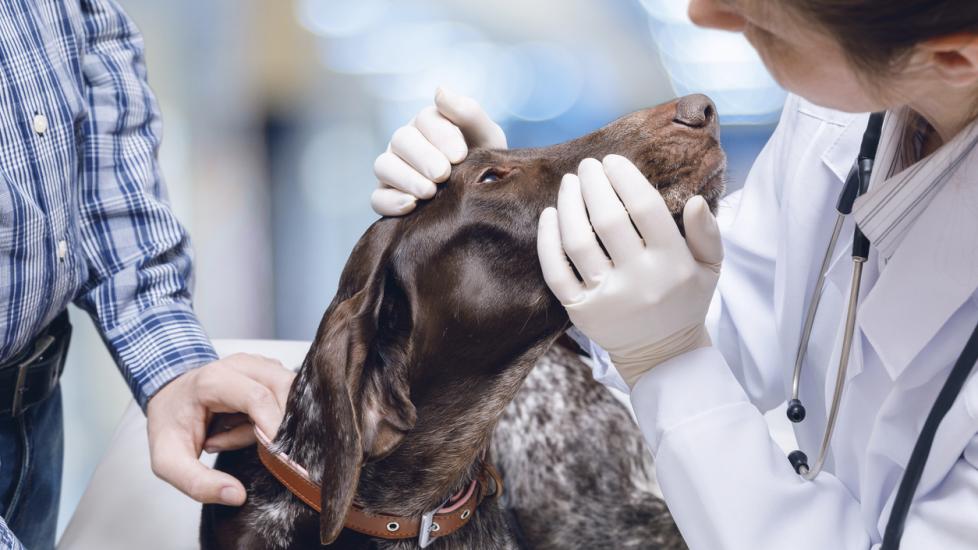Nasal Polyps In Dogs
What Are Nasal Polyps in Dogs?
Nasal polyps are noncancerous growths in the nose caused by chronic inflammation in the sinuses, known as rhinitis. These growths are sometimes visible and look like pink protruding tissue in the nostril. However, in most cases these growths, which cause chronic sneezing and nasal drainage, are located deep within the nose and cannot be seen.
A nasal polyp is a type of noncancerous tumor. The word tumor simply refers to an abnormal growth of tissue, which can be either benign (not cancerous) or malignant (cancerous). Nasal polyps are a benign tumor type. They do not spread to other parts of the body or aggressively invade nearby tissues. While polyps are abnormal growths that shouldn’t be present, they are generally not considered dangerous on their own.
However, there is a possibility that polyps can turn into cancer over many years, so it is recommended to have them removed if possible. Nasal polyps are not considered a medical emergency.
Symptoms of Nasal Polyps in Dogs
- Sneezing
- Nasal discharge
- Stertor (congested breathing sound)
- Decreased sense of smell
- Rarely, pink tissue may be visible protruding from a nostril
Causes of Nasal Polyps in Dogs
Nasal polyps in dogs are primarily caused by chronic inflammation in the nose. This chronic inflammation can arise from a variety of factors, including the presence of an inhaled foreign body (such as weed seeds) or chronic infections.
Additionally, environmental irritants like cigarette smoke have been linked to an increased risk of nasal tumors in dogs. Nasal polyps are much more common in cats than in dogs, where they are relatively rare.
Some studies indicate that nasal polyps are more likely to occur in dolichocephalic and mesocephalic breeds such as Greyhounds, Collies, Setters, and Dachshunds, which are characterized by long and slender noses. These particular breeds have elongated nasal passages, making them more susceptible to inflammation within the sinuses and nose caused by inhaled seeds, bacteria, viruses, or fungi. Labrador Retrievers may also have a potential breed predisposition to nasal polyps.
How Veterinarians Diagnose Nasal Polyps in Dogs
Veterinarians typically diagnose nasal polyps by visualizing the polyp. In some cases, the polyps may be visible just inside the nostril and look like pink, shiny bits of tissue. However, it is uncommon for the polyps to be easily visible in this way. In such cases, sedation may be required to allow the veterinarian to examine the nose more thoroughly. Most of the time, the polyps are located deeper in the nasal passages and can only be seen with a specialized tool. The rhinoscope is a long, thin instrument with a tiny camera on the end, enabling the veterinarian to visualize the polyps and make a definitive diagnosis.
Treatment of Nasal Polyps in Dogs
The recommended treatment for nasal polyps in dogs is surgical removal, if feasible. Often this is performed with endoscopy. After the polyp is removed, it is recommended to send it for biopsy to confirm that it is just a benign polyp and not cancerous. It is crucial to ensure that the stalk of the polyp is removed during the surgery; otherwise, it may grow back. In some cases, extracting the stalk can be challenging.
In cases where surgery is not an option, whether because of the location of the polyp; safety concerns due to the age of the dog, concurrent disease, and anesthesia use; or financial reasons, medical treatment options—though not as effective as surgery—may be considered as alternatives. These include the use of steroids (prednisone) or non-steroidal anti-inflammatory drugs (piroxicam) in combination with radiation therapy or antibiotics for secondary bacterial infections.
Recovery and Management of Nasal Polyps in Dogs
After surgery, it’s normal for dogs to experience bloody drainage for a week or two. To prevent your dog from rubbing or pawing at their nose, they should wear a recovery cone. Be sure to keep the cone on at all times when your dog is unsupervised. During the recovery period, closely monitor your dog and contact your veterinarian immediately if they show signs of not eating, lethargy, depression, or excessive bleeding.
Dogs can live with nasal polyps even if surgery is not feasible. While chronic sneezing may become a part of your dog’s life, it is important to monitor for secondary infections. The polyp may serve as a site of bacterial growth, leading to symptoms such as green-yellow nasal drainage, depression, or poor appetite. If you notice any of these changes, talk to your veterinarian about medical treatment and supportive care.
Nasal Polyps FAQs
How long can a dog live with a nasal polyp?
The prognosis for a dog with a nasal polyp varies dramatically, depending on the size and location of the polyp. A large polyp obstructing the nasopharynx can lead to breathing difficulties and a shorter survival time, while a small polyp closer to the nostril may have minimal to no impact on a dog’s lifespan. In cases where a large polyp obstructs the airway and significantly affects a dog’s quality of life, euthanasia may be considered.
How much does it cost to remove a nasal polyp in a dog?
The cost of removing a nasal polyp in a dog can vary depending on factors such as the location of the polyp and the extent of the surgery required. If the polyp can be accessed externally or through a scope, the cost may be lower. However, if extensive facial surgery or a CT scan is needed, the cost can increase. On average, the cost of polyp removal in dogs can range from $600 to $5,000.
Featured Image: iStock.com/Natali_Mis
References
Help us make PetMD better
Was this article helpful?
